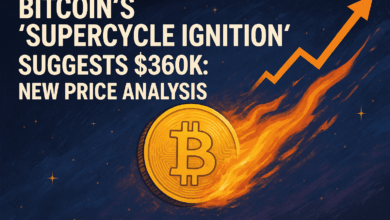What it means for crypto investors
As the cryptocurrency landscape continues to evolve, few developments have had as immediate an impact as the recent $4 billion increase in stablecoin supply, spurred by fresh legislation emerging from Washington. While Bitcoin and Ethereum remain in the spotlight, it’s this regulatory progression—and the capital it sets free—that could be the most pivotal shift in today’s digital asset ecosystem. For savvy investors, this is a defining moment—a turning point where early positioning could lead to asymmetric gains.
Regulatory Clarity Awakens Dormant Capital
The momentum stems in large part from a newly proposed stablecoin bill in the United States, which offers long-awaited legal clarity for the issuance, management, and utilization of fiat-backed digital currencies. For years, institutional participants have been hesitant to dive fully into the crypto space due to unclear or inconsistent regulatory treatment. This hesitation effectively left billions of dollars on the sidelines. But now, with regulatory green lights flashing, that sidelined capital is reentering the ecosystem—fast.
The legislation addresses key pillars such as reserve requirements, auditing standards, consumer protections, and oversight frameworks. Importantly, it carves out space for both private enterprise and public institutions to coexist, fueling innovation while providing important safety rails. This is the kind of validation that not only encourages existing players to scale but also entices new entrants—major banks, payment processors, and even multinational corporations—to jump into the ring.
This is about more than just compliance. We are witnessing the early stages of the next evolution in finance—one in which fiat currencies go native to the blockchain. Picture a near future where high-volume money transfers, payroll, remittances, cross-border trade, and even debt instruments are all issued and settled in real-time using programmable stablecoins. It fundamentally redefines what liquidity and transparency mean in a digitized economy.
Such rapid changes set the tone for a broader financial transformation. From decentralized identity layers to automated compliance logic, the infrastructure being built on top of highly regulated stablecoins could be the scaffolding that allows DeFi and traditional finance (TradFi) to finally bridge.
Why Investors Shouldn’t Sleep on Stablecoins
Stablecoins are often overlooked by retail investors enticed by the explosive gains of altcoins and meme tokens. However, while they may lack price volatility, stablecoins are the grease that enables the crypto economy to operate with increasing speed and efficiency. They are the foundational base currency for most DeFi operations—from lending protocols and yield farms to decentralized exchanges and asset swaps.
The increase in stablecoin issuance is a clear proxy for rising demand, deeper liquidity pools, and stronger utility across the blockchain ecosystem. Ethereum remains the dominant host platform, but competitors like Solana, Avalanche, Cosmos, and newer Layer 2s like Arbitrum, Optimism, and Base are attracting considerable activity thanks to their scalability and developer-friendly tools.
In many ways, stablecoin volume acts as a health indicator for the crypto space. During bull runs, rising stablecoin inflows typically precede surges in speculative trading. During bear cycles, they represent safe harbor assets used for hedging or capital preservation. Regardless of the sentiment, these digital dollars are central to investor behavior and platform functionality.
Moreover, as governments and central banks move studiedly toward issuing Central Bank Digital Currencies (CBDCs), private stablecoins such as USDC, USDT, and new entrants like PayPal’s PYUSD or Circle’s Euro Coin (EUROC) present a competitive and complementary path forward. The ecosystem is not just surviving—it’s diversifying and thriving.
The Ecosystem Ripple Effects of Stablecoin Growth
Where stablecoins go, opportunity follows. Expanding stablecoin circulation means higher transaction volumes, increased protocol activity, and new business models built on top of programmable currency. For developers, it opens access to low-volatility instruments ideal for applications in micropayments, subscriptions, remittances, and B2B finance. For users, it means faster settlements and fewer fees—especially compared to traditional banking systems.
Institutional momentum also drives demand for robust on/off-ramp solutions, secure custody, insured depositories, and regulatory-compliant API infrastructure. Each one of these categories is ripe for investment by those looking to build exposure to the picks and shovels of the stablecoin economy.
For a deeper understanding of investor personas in this dynamic landscape, review this Crypto Investor profile breakdown to align strategies with risk appetites and market cycles.
How to Invest in the Coming Stablecoin Boom
- Decentralized Finance (DeFi) Lending Platforms: Growing stablecoin supplies translate to proportional growth in lending and borrowing activity. Leading platforms like Aave, Compound, and newer entrants like Morpho or Silo are well-positioned to benefit from increased liquidity and demand for yield-bearing instruments.
- Blockchain Infrastructure Projects: Ethereum, Polygon, Solana, Avalanche, and Fantom are the workhorses powering the day-to-day movement of stablecoins. Usage growth leads to greater demand for block space, driving up network value and potential token appreciation.
- Supporting Technology and Compliance Ecosystem: Companies building APIs, KYC/AML toolkits, oracle integrations, and merchant payment rails stand to gain handsomely. Projects like Chainlink, Fireblocks, Circle’s API suite, and newer compliance startups need to be on your radar.
- Stablecoin-based Yield Aggregators and RWA Platforms: Protocols that bridge the gap between traditional finance yields and blockchain settlements—such as Ondo Finance, Maple Finance, or Goldfinch—help amplify stablecoin utility while offering lower-risk investment options tied to real-world cash flow.
- Tokenized Treasury Products: A significant development is the emergence of tokenized U.S. Treasury bills, which offer stablecoin investors secure, yield-bearing assets. Projects like Franklin Templeton’s BENJI token, OpenEden, or Tradeteq could shape the next generation of fixed-income DeFi products.
Risks and Red Flags Investors Must Consider
While the promise is immense, the road ahead carries risk. Chief among them is the growing centralization of stablecoin governance. As large banks and regulated entities enter the space, the ethos of decentralization could be compromised. There’s a legitimate concern that the largest winners here may be centralized issuers backed by government-friendly policies—entities like Circle (USDC) or even a future Federal Reserve-backed digital dollar.
Additionally, reliance on any single jurisdiction—especially the United States—introduces geopolitical, legal, and monetary policy risks. Stablecoin users should be mindful that integration with traditional systems may come with restrictions, freezes, or surveillance that contradict the privacy principles at crypto’s core. These risks necessitate a balanced investment approach.
Consider diversifying across multiple stablecoins and blockchain networks. Blend exposure to centralized options with decentralized alternatives like DAI, GHO, or even newer algorithmic models. Strategic hedging is essential not only for risk management but also for maximizing upside in scenarios of regulatory divergence.
Another wise strategy? Embrace the mindset of a Contrarian Investor. Too often, retail investors follow narratives well after institutional players have positioned themselves. By seeking overlooked or underpriced assets within the stablecoin ecosystem today, you position yourself for gains tomorrow, before the headlines catch up.
Stay Vigilant. Fortune Rewards the Informed.
This $4 billion surge is not just an anomaly—it’s a monstrous signal. The capital injection is a leading indicator of something much larger underway: the merging of traditional financial scale with decentralized financial efficiency. Regulatory clarity has flicked the switch, and institutional liquidity is flooding in.
Stablecoins, once dismissed as vanilla instruments, are now essential to markets, from blockchain-native savings accounts to global remittance apps, enterprise ERP platforms, and sovereign monetary policy tools. We’re looking at a megatrend in the making.
As an informed investor, your edge comes from recognizing fundamental shifts before they achieve mass consciousness. Follow the infrastructure, track the adoption rates, understand the stakeholders. Whether you’re positioning through direct investments, governance tokens, service providers, or diversified index-type solutions, the objective remains the same: capitalize on transformation before it’s priced in.
The next time a Bitcoin price prediction makes waves, ask yourself—how did that capital get there so quickly? Chances are, a stablecoin had something to do with it.
Source link





